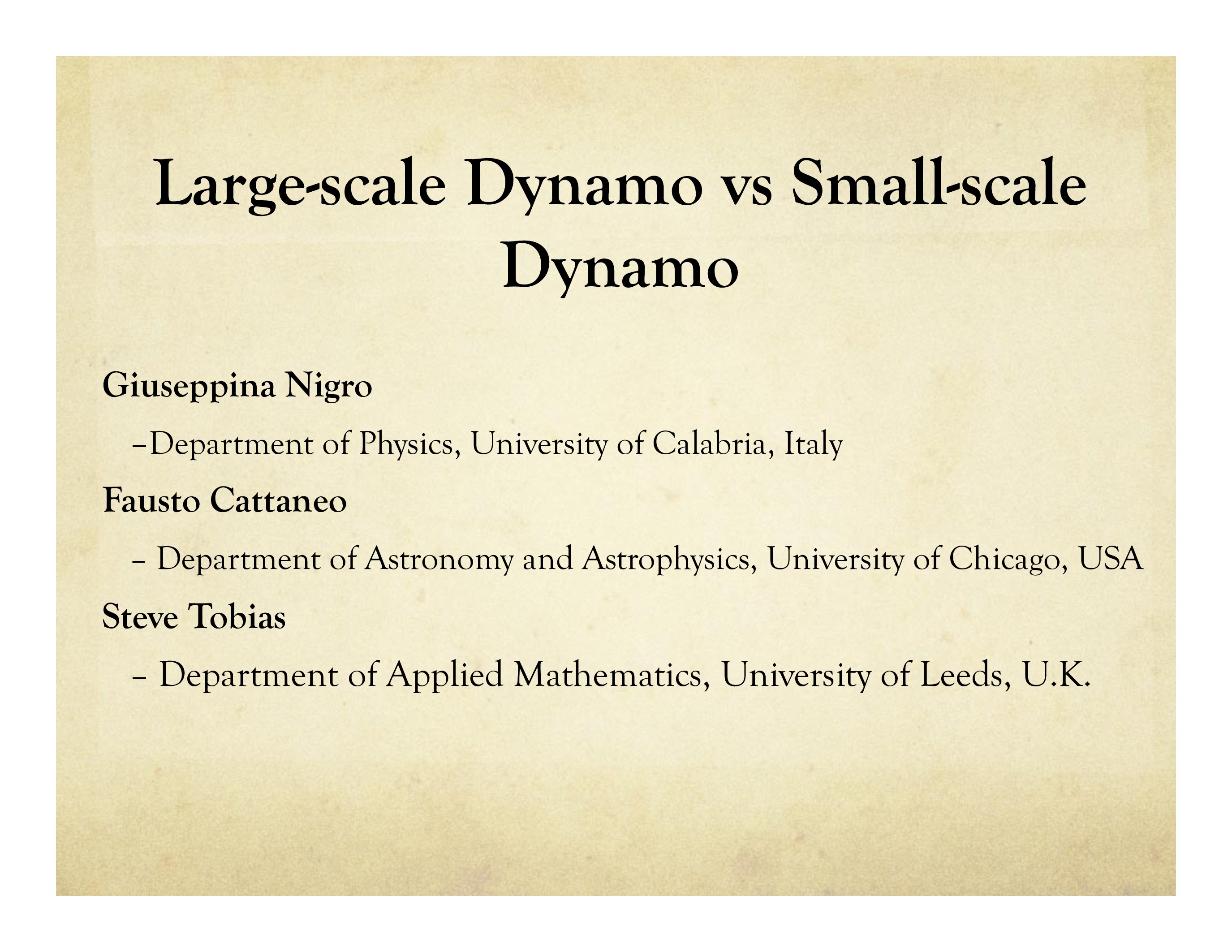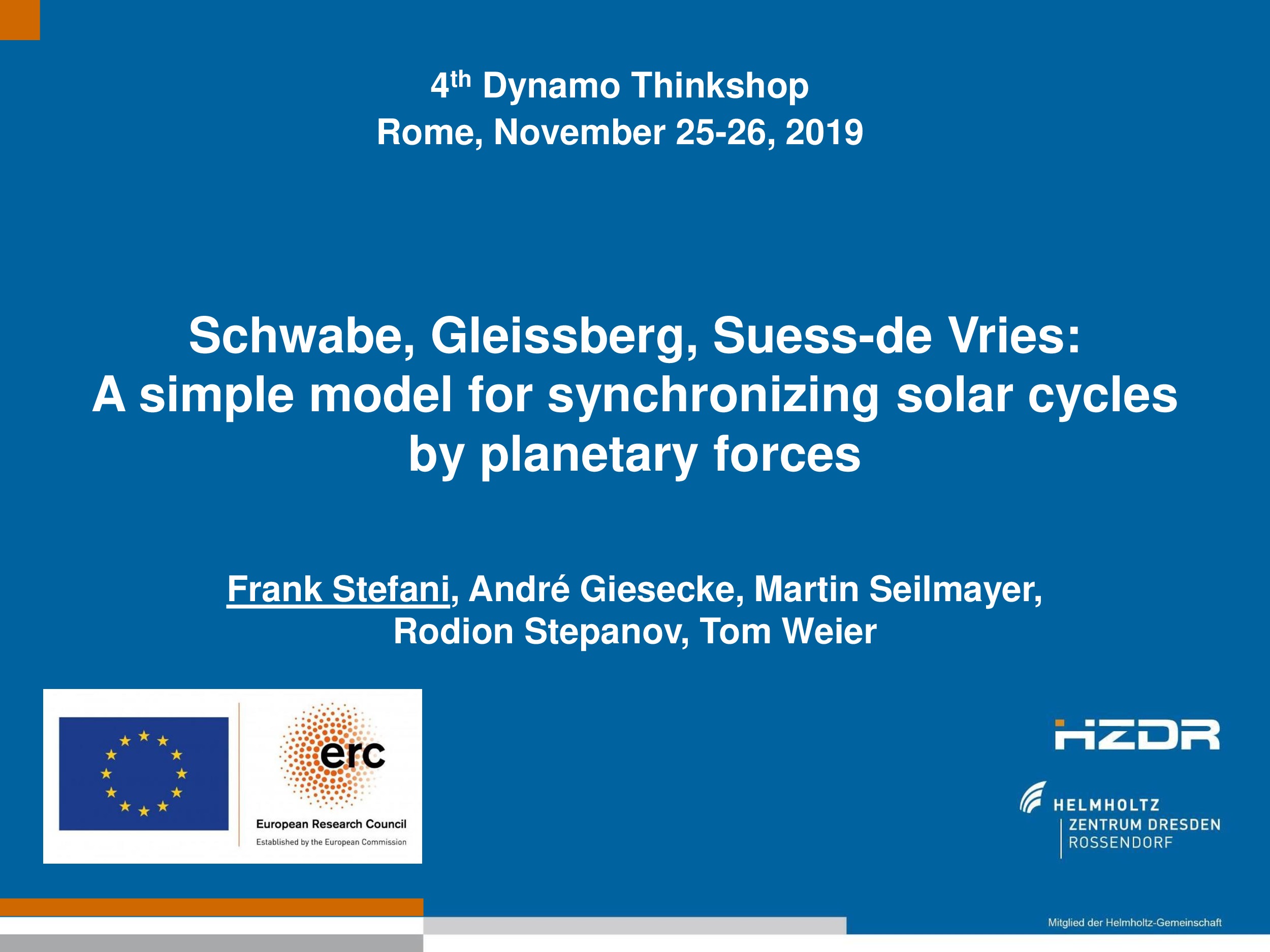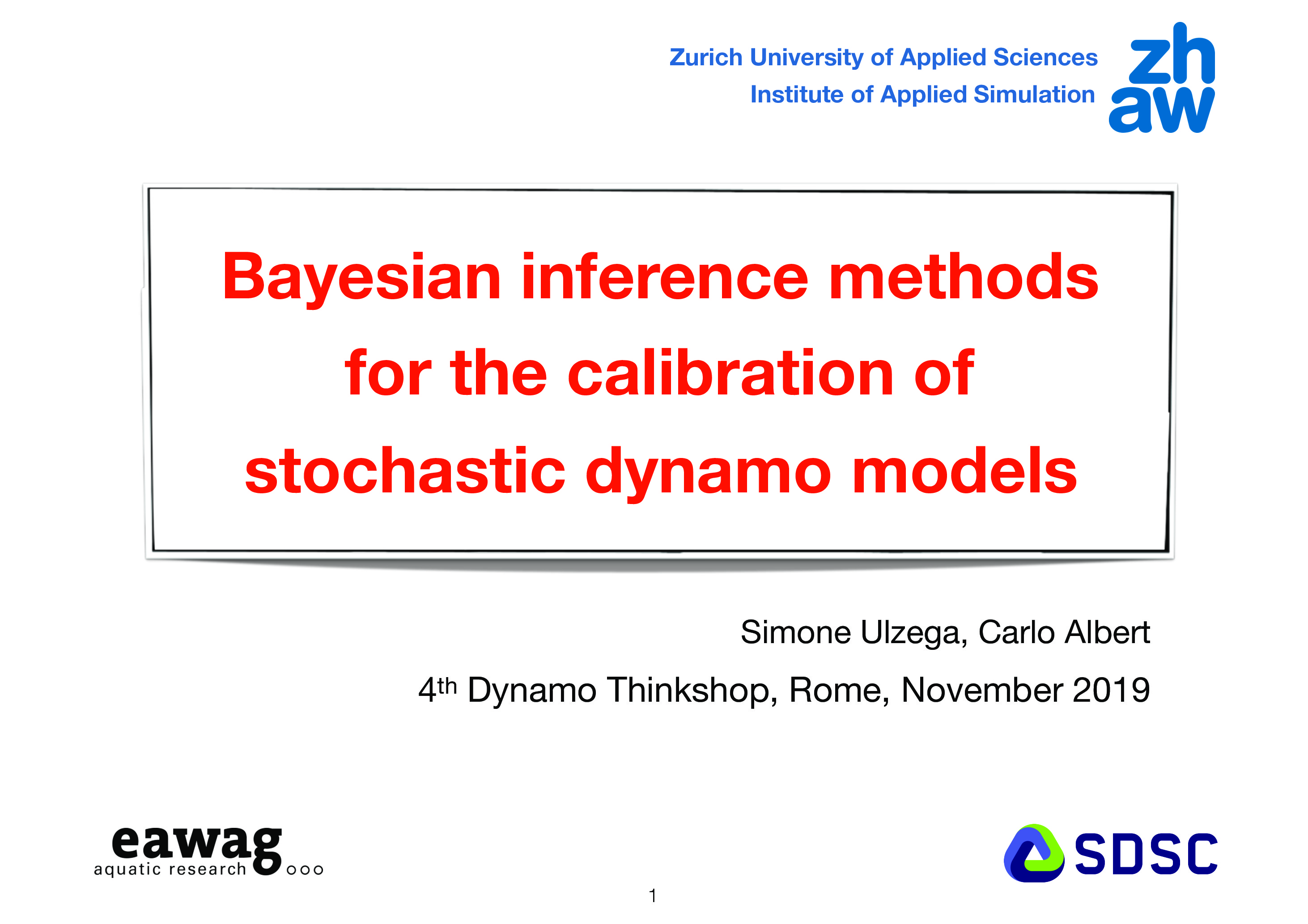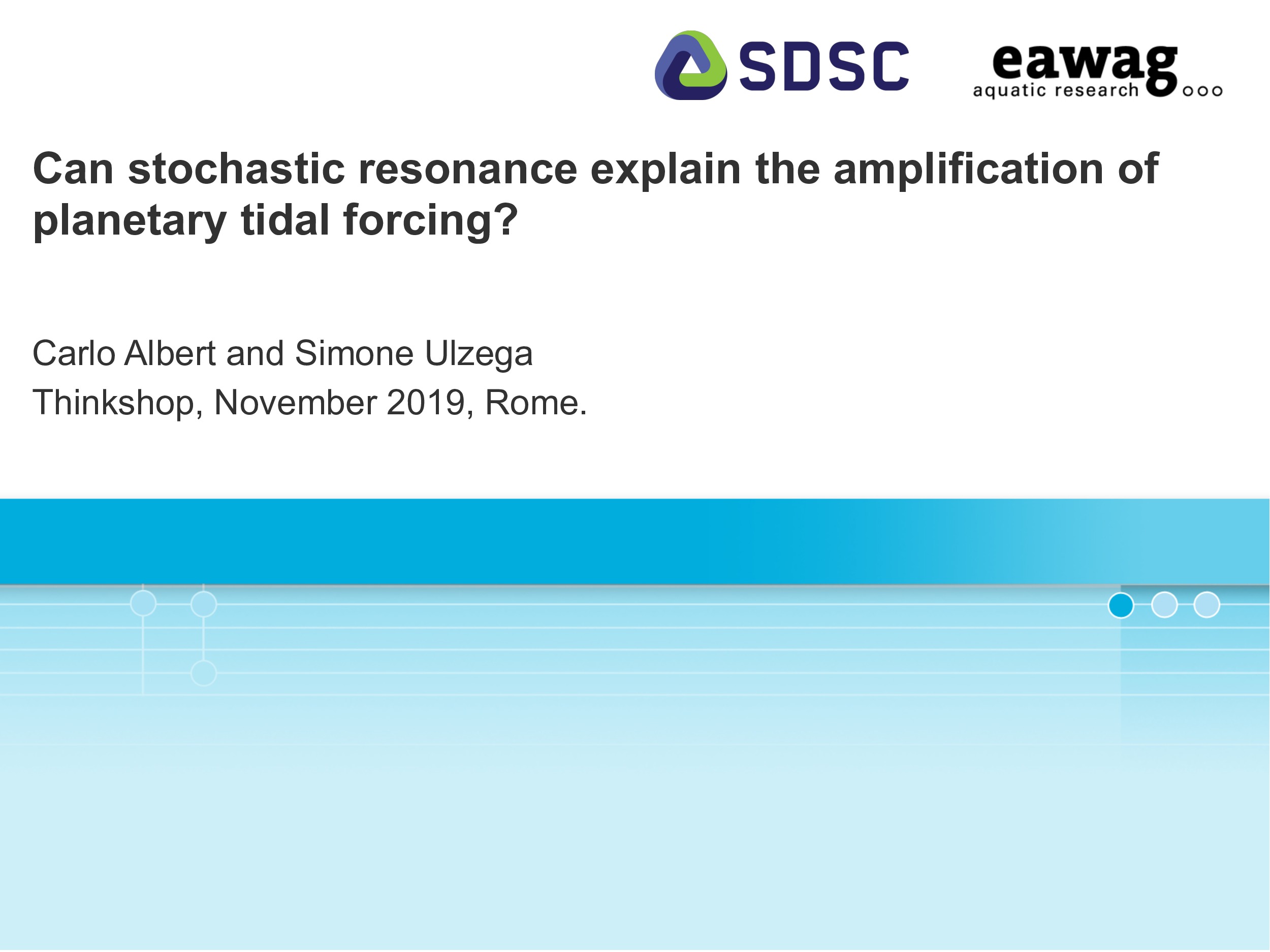
The workshop format, since its first edition, aims at encouraging free and relaxed discussion over topics in Solar/Stellar Dynamo, notably revolving around possible links between planetary tides and the Solar Cycle, evidences from paleocosmic ray records, solar data, theoretical matters and models.
Participants:
Carlo Albert Swiss Federal Institute of Aquatic Science and Technology, Switzerland
Alessandra Ambrifi Dept. of Physics, Univ. Rome Tor Vergata, Italy
Svetlana Berdyugina Leibniz-Institut fuer Sonnenphysik (KIS), Germany
Francesco Berrilli Dept. of Physics, Univ. Rome Tor Vergata, Italy
Juerg Beer Swiss Federal Institute of Aquatic Science and Technology, Switzerland
Robero Benzi Dept. of Physics Univ. Rome Tor Vergata, Italy
Alberto Bigazzi Dept. of Physics Univ. Rome Tor Vergata, Italy
Giuseppe Consolini INAF-IAPS, Italy
Dario Del Moro Dept. of Physics, Univ. Rome Tor Vergata, Italy
Andre Giesecke Helmholtz-Zentrum Dresden-Rossendorf, Germany
Luca Giovannelli Dept. of Physics Univ. Rome Tor Vergata, Italy
Antonio Ferriz Mas Univ. Vigo, Spain
Valentina Penza Dept. of Physics Univ. Rome Tor Vergata, Italy
Ermanno Pietropaolo Univ. Di L’Aquila, Italy
Rafael Rebolo Instituto de Astrofísica de Canarias, Spain
Markus Roth Leibniz-Institut fuer Sonnenphysik (KIS), Germany
Martin Seilmayer Helmholtz-Zentrum Dresden-Rossendorf, Germany
Frank Stefani Helmholtz-Zentrum Dresden-Rossendorf, Germany
Rodion Stepanov Institute of Continuos Media Mechanics, Russia
Simone Ulzega Swiss Federal Institute of Aquatic Science and Technology, Switzerland
José Manuel Vaquero Universidad de Extremadura, Spain
Tom Weier Helmholtz-Zentrum Dresden-Rossendorf, Germany
Berrilli F. (chair) , Bigazzi A., Del Moro D., Ferriz Mas A., Giovannelli L., Pietropaolo E.
Francesco Berrilli
Antonio Ferriz Mas
tba
Preliminary Program:
Monday 25th of November
9:45 Registration and coffee
10:15 Welcome (A. Bigazzi)
Session Dynamo
10:30 Stochastic Resonance in complex systems, R. Benzi
11:00 Schwabe, Gleissberg, Suess-de Vries: A simple model for synchronizing solar cycles by planetary forces F. Stefani, A. Giesecke, M. Seilmayer, T. Weier
11:40 Can stochastic resonance explain the amplification of planetary tidal forcing? C. Albert and S. Ulzega
12:10 Baysian inference methods for the calibration of stochastic dynamo models S. Ulzega and C. Albert
12:40 Lunch
14:00 Synchronization in mean field dynamo models and precessing flows A. Giesecke, M. Seilmayer, F. Stefani, T. Weier
14:30 Solar magnetic variability: main period and other periods; where do they come from? A. Ferriz Mas
15:00 Synchronization and dynamic quenching in a simple model of alpha-omega-dynamo R. Stepanov
15:30 Large-scale Dynamo vs Small-scale Dynamo G. Nigro, F. Cattaneo and S.M. Tobias
16:00 Coffee break
16:15 Signal-to-Noise Resonance in Geomagnetic Polarity Reversals G. Consolini
16:45 Helioseismology of Solar Rotation, M. Roth
17:15 Discussion
20:00 Social Dinner in Trastevere
Tuesday 25th of November
Session Long-Term Solar Variability
10:00 Long-term (1749-2015) variations of solar UV spectral indices, Berrilli F., Criscuol S.i, Lovric M., Penza V.
10:30 Challenges and limitations of the long-term sunspot-number record, José M. Vaquero
11:00 Annual information on solar cycles from tree rings and ice cores, Jürg Beer
11:30 Historical TSI reconstruction from Solar Modulation Data, Penza V., Berrilli F., Criscuoli S.
12:00 A model for Earth's climate sensitivity to solar irradiance variations, R. Reda, F. Lepreti, L. Primavera, A.Vecchio.
12:30 Wavelet analysis of the phase locking effect in the real and simulated data of solar activity D. Sekulov
12:45 Discussion
13:00 End of Thinkshop
The meeting will start on Monday, November 25, 2019, at 10:00.
No fee required to attend, simply register for the meeting.
Dipartimento di Fisica
Università degli Studi di Roma Tor Vergata
Aula Grassano
Rome is a very touristic city and there is a very big offer of hotels and apartments. You can check at any booking site and choose your hotel. However, I will propose you a short list of hotel which have reasonable prices and are close to the metro A stops which take you to the university.
Check in 24/11 – Check out 26/11
Exe International Palace****
Via Nazionale
60 Euros per night without breakfast
68 Euros per night with breakfast
Hotel Mondial****
Via Torino
49 Euros per night without breakfast
Mercure Roma Centro Colosseo****
Via Labicana
90 Euros per night without breakfast
98 Euros per night with breakfast
If you are interested, you can write to Eman (eman@eurekatravel.it) in order to have support and book/pay in advance one the listed hotels.

Session: Dynamo

Session: Dynamo

Session: Dynamo

Session: Dynamo
| First Name | Last Name | Affiliation |
|---|

